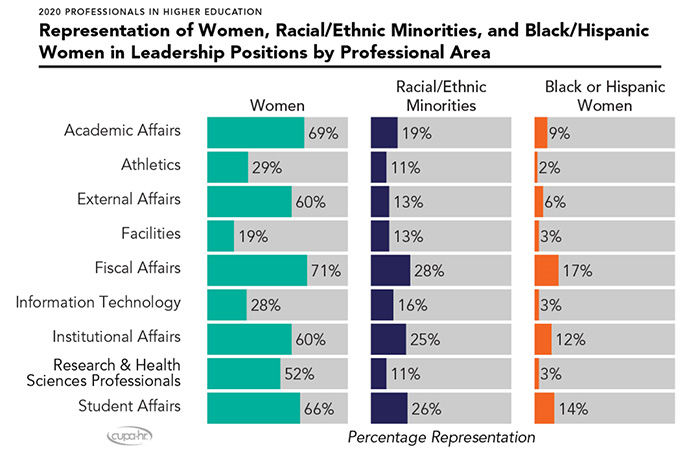CUPA-HR Report Examines Professional Leadership Positions in Higher Education
Professional leadership positions in higher education often serve as the pipeline to higher-level administrative positions. For this reason, it is crucial to examine representation among these positions.
CUPA-HR’s recently released 2020 Professionals in Higher Education Annual Report surveyed 396 professional positions. Of those positions, 38 percent are leadership positions that require supervising others or directing operations of an office, department or other functional area.
Findings from the report show that representation of women and racial/ethnic minorities in leadership positions varies by professional area. Women are well represented in leadership positions in most, but not all, professional areas. In addition, although racial/ethnic minorities and Black/Hispanic women are represented well in professional positions overall, they are underrepresented in leadership positions in most professional areas.

Though fiscal affairs positions have the highest representation of both women and racial/ethnic minorities in leadership positions, no single fiscal affairs position accounts for strong representation of both women and racial/ethnic minorities in leadership positions. For instance, women are most represented in student account receivables manager positions (83 percent), but this position has the fourth lowest representation of minorities within fiscal affairs (19 percent).
In professional leadership positions, women are generally paid less than their male counterparts. Black/Hispanic women have some of the lowest pay ratios in comparison to White men, particularly in leadership positions in information technology and athletics, where pay ratios are less than $.90 on the dollar.
Other findings from the CUPA-HR 2020 Professionals in Higher Education Annual Report include:
- Higher education professionals overall received a median salary increase of 2.66 percent over the past year, which is the highest increase they have received since 2016-17. Associate’s institutions provided the highest salary increases for professionals at 3.05 percent.
- The professional area that is largest in size is academic affairs, with a median of 30 academic affairs professionals per institution. The area with the highest salaries is facilities, where professionals are paid a median salary of $77,000.
- Women represent 60 percent of higher ed professionals, and racial/ethnic minorities make up 23 percent. This representation varies by professional area. Women are not well represented in the areas of facilities (21 percent), information technology (27 percent), or athletics (30 Professionals Reportpercent). Racial/ethnic minorities are not well represented in the areas of external affairs (5 percent), facilities (5 percent) or athletics (7 percent).
- The area of facilities has the highest median age (53 years) and time in position (six years) of any professional area.
A total of 254,160 professionals were reported for this year’s survey by 1,114 higher education institutions, covering 396 positions. This survey collects data at the incumbent (non-aggregate) level for all professionals reported, allowing for the collection of salary, sex, race/ethnicity, age and years in position.
To learn more about the Professionals in Higher Education Survey, read the overview. Salaries, demographic comparisons and detailed trend information are available in the full report.


